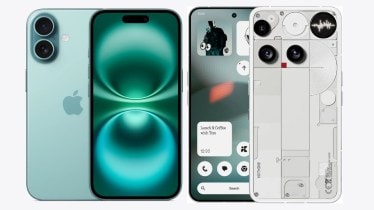The Nothing Phone 3 is here and with a starting price of Rs 79,999, it is aimed squarely at the iPhone 16. In fact, you can get a brand new iPhone 16 for much less than what the Nothing Phone 3 costs. Is that worth it though?
From a specifications point of view, the Phone 3 looks exciting. A standout design with a new Glyph Matrix interface, a versatile set of triple rear cameras, substantial battery capacity, and a slick yet capable OS. The iPhone 16, on the other hand, comes across as a no-nonsense premium experience. It has a fast chipset, an instantly recognisable design, a stellar battery stamina and a dependable camera system.
With prices competing for your attention, which of these smartphones should you opt for? We pitted both these devices against each other on the basis of their specifications sheet to find out.
Design and Build
The Nothing Phone 3 stays true to the brand’s roots with a distinctive semi-transparent aesthetic, though it evolves the signature Glyph Interface. A new Glyph Matrix on the rear, a dot-matrix display made of 489 LEDs offers more utility like simple widgets and customisable alerts. The Phone 3 features a metal frame with Gorilla Glass Victus, which along with IP68 rating for dust and water resistance, makes it durable to the world. Its camera layout on the rear is notably unconventional, with three separate lenses rather than a single module.
In contrast, the Apple iPhone 16 maintains a now-familiar yet refined design language. The vertically stacked dual rear cameras lend it an edge of freshness and the premium matte glass in attractive colourways makes the iPhone 16 look more appealing. The stronger Ceramic Shield for enhanced durability and an IP68 rating certifies its durability. The Camera Control key is a great utility for photographers and the Action Button makes life a tad easier by assigning shortcuts to device functions.
Display
The Nothing Phone 3 sports a 6.67-inch flexible AMOLED display with a 1.5K resolution, a smooth 120Hz adaptive refresh rate, 1600 nits of typical brightness and 4,500 nits peak brightness for HDR content. The iPhone 16 features a smaller 6.1-inch Super Retina XDR OLED display with just 60Hz refresh rate and a peak brightness rating of 2,000 nits. The Dynamic Island masks the camera cutout but eats into the space. Hence, it is an easy win for the Nothing Phone 3.
Performance
Under the hood, the Nothing Phone 3 is powered by the Qualcomm Snapdragon 8s Gen 4 chipset, fabricated on a 4nm process. This chip offers the same sort of performance as 2024 Android flagships, which lens it a disadvantage against the iPhone 16. Nothing tries to make up for it with 12GB or 16GB of LPDDR5X RAM and up to 512GB of UFS 4.0 storage. The Nothing OS 3.5 interface based on Android 15 has nifty little AI-bred features to make life a tad easier and the minimalist aethtics make it a nerd’s dream. Nothing promises up to 5 years of Android OS updates.
The iPhone 16 dominates this space with its mighty 3nm A18 processor that offers significantly greater raw performance for both CPU-intensive tasks and AI functions. With 8GB RAM, the iPhone 16 can manage everything you throw at it. The iOS 18 interface is functional and feature-rich for everyday tasks. While it lags behind in features, iOS 18 is refined and offers a qualitative app experience. Apple Intelligence features make basic tasks easy and with iOS 26 incoming, the UI experience will get even better. Apple usually supports its iPhones up to six years.
Hence, the iPhone 16 takes points here, regardless of the promises Nothing makes for the Phone 3.
Camera
The Nothing Phone 3 brings a significant camera overhaul, featuring an all-50MP triple-camera setup. This includes a 50MP f/1.68 main camera with OIS/EIS, a 50MP f/2.68 periscope lens offering 3x optical zoom and up to 60x AI Super Res Zoom, a 50MP ultra-wide (114° FOV), and a 50MP front camera. It supports 4K Ultra XDR video at 60fps.
The iPhone 16 features a 48MP main sensor with 2x lossless zoom and 24MP still photo resolution, along with a 12MP ultrawide lens. The shift to a vertical camera alignment is primarily to enable spatial video capture. The front camera remains 12MP with software improvements.
While the iPhone 16 loses out on a proper zoom camera, the overall quality of output and the video performance is far superior to the Nothing Phone 3.
Battery and Charging
The Nothing Phone 3 houses Nothing’s largest battery to date, with a 5,150 mAh silicon-carbon cell (Indian variant) and supports rapid 65W wired fast charging, capable of filling the phone from 1% to 100% in roughly 54 minutes. It also supports 15W wireless charging and 5W reverse wireless charging.
The Apple iPhone 16 gets an undisclosed battery but manages to offer an entire day’s stamina. Charging speeds are limited to around 20W-25W wired and there’s support for MagSafe wireless charging too.
The Nothing Phone 3, however, takes the lead in this case.
Price
The Nothing Phone 3 has launched in India with a starting price of Rs 79,999 for the 12GB/256GB variant, going up to Rs89,999 for the 16GB/512GB model. This positions it firmly in the premium segment.
The Apple iPhone 16 is currently available for as low as Rs 71,999 at Vijay Sales, thus making it a lot more accessible.
Conclusion
Choosing between the Nothing Phone 3 and the Apple iPhone 16 boils down to your priorities. However, based on the comparison, the Apple iPhone 16, despite its age and hardware limitations, ends up being the better value for money deal. The extra performance, coupled with the class-leading camera experience, makes the iPhone 16 a better recommendation. The Nothing Phone 3, on the other hand, makes sense if you love the Android ecosystem, prefer Nothing’s tinkering of the OS and the unique touches to the feature set (like the Glyph Matrix).
